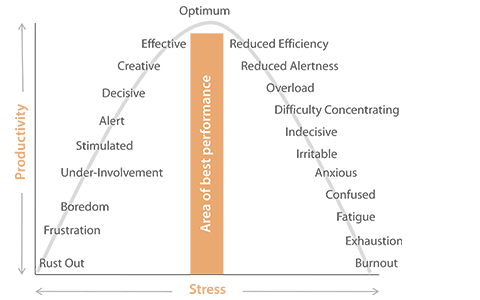Not all stress is bad

In day to day life, the term “stress” is often used to describe negative situations.
This leads many people to believe that all stress is bad for you, and this is not actually true.
Stress is not always a bad thing. It’s simply the body’s response to changes that create challenging demands. Many professionals suggest that there is a difference between what we perceive as positive stress (eustress), and negative stress (distress).
Eustress is the term applied to stress that has a positive motivational effect on us. In other words, “good” stress. Eustress is generally short term and has a far more positive impact on our health and wellbeing. It often comes from situations that are enjoyable such as getting a promotion at work or starting a new job. We all need some levels of eustress in our lives but this stress needs to be managed so it doesn’t get out of control and become distress. Without sufficient eustress levels we become bored and unmotivated.
Have you ever experienced one of those rare days at work where you have only one or two minor things to do? There is no pressure to get them completed and therefore no real motivation to do them. These are the days when we can get home and think to ourselves ‘I didn’t achieve anything today’.
Positive stress has been described as having the following characteristics:
- motivates, focuses energy
- is short-term
- within our coping abilities
- feels exciting
- improves performance.
Distress is the term applied to stress that has a negative motivational effect on us, or “bad” stress. Distress occurs in situations that are not enjoyable such as conflict in the workplace or feeling inundated and overwhelmed with tasks we need to complete. Both eustress and distress have been widely researched and it has been well documented that long term distress can have a significant negative impact on our overall health and wellbeing, both physical and mental.
Negative stress, in contrast to positive stress, has been described as having the following characteristics:
- causes anxiety or concern
- can be short or long-term
- outside of our coping abilities
- feels unpleasant
- decreases performance
- can lead to mental and physical problems.
As seen in the diagram, not enough positive stress (eustress) can result in “rusting out”, and boredom. Too much negative stress (distress) can lead to “burnout” and exhaustion. The optimum level is a balance between the two.

A good starting exercise to help you learn more about the different types of situations that can cause stress, and the different types of stress you can experience, is to keep a stress journal. A stress journal is where you can list all of the good and bad stress factors, both internal and external, as you identify and perceive them.
Some of the things you can record in your journal are:
- Describe the stress factor you identified (include the time and place).
- Was it good stress (eustress) or bad stress (distress)?
- Was it internal (eg own worries, fears, or perfectionist expectations of self etc) or external (eg conflict at work, excessive task demands, etc)?
- What impact it had on you? (and if in the workplace – what impact it had on you and/or your team?)
Overall stress is a normal part of life, but at times it may be too much and feel out of control. In the right quantities, stress is good; it can motivate you and help you become more productive. However, too much negative stress, or a strong negative response to stress can be harmful. How we perceive a stress-provoking event and how we react to it is also important to understand, as this can determine its impact on our health.
Enhance your leadership development skills with courses at Odyssey Training.
There are many stressors in this modern world that can lead to low levels of resilience. If you don’t learn how to cope with your stressors, this can impact your wellbeing and focus at work. Resilience and Stress Management 1-day training will provide you with practical tools and techniques to help you identify your stressors and build your resilience.



























